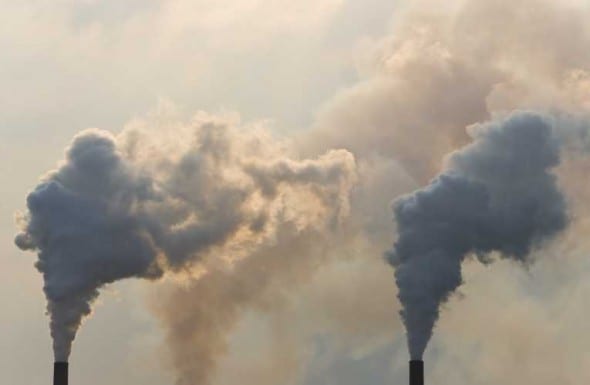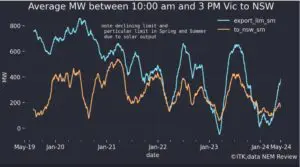
The year to April 2016 saw increases in electricity demand, electricity generation and emissions from generation in the National Electricity Market, continuing the general pattern of the past seventeen months.
Total electricity demand increased for the fourteenth successive month in the NEM and the eighth successive month in Western Australia. There can be little doubt that the period of falling demand for electricity across Australia has now ended.
Total annual demand in the NEM is now 2.8% higher than the low point recorded in the year to February 2015. Sustained demand growth at this sort of rate was considered normal in the electricity industry up to about 2004, but until now had not been seen since then.
Total emissions from electricity generation in the NEM increased again in the year to April 2016. Annual emissions were 5.7% higher than in the year to June 2014.
Total coal generation was 76.2%, compared with a minimum of 72.3% in the year to July 2014. Gas generation recorded another small reduction, to 10.6%, notwithstanding an increase in Tasmania to meet the supply shortfall caused by the failure of Basslink.
Total renewable generation was 13.1%. However, when small scale solar and other distributed generation sources are included alongside large scale renewable, such as wind farms and hydro, the renewable share of total supply increases to 16.4% for the NEM as a whole.
It is much higher in South Australia and also, of course, Tasmania.
Demand
Total demand in the year to April 2016 in Australia’s two main electricity systems, the NEM and the WA South West Interconnected System (SWIS), continued the trends reported in the last few issues of CEDEX Electricity Update.
Among individual NEM regions (states) the main exception was Tasmania, where demand reductions by major industrial consumers form part of the response to the supply crisis (Figure 1 below).
The major driver of demand growth overall is growing electricity consumption in the Queensland coal seam gas fields. However, it is most important to appreciate that demand is also growing everywhere else, just not so fast.

In each of the other four NEM states the change from decreasing to increasing demand appears to have happened around March 2015. From then until April 2016, annual demand has increased by 2.2% in NSW and 3.2% in SA.
In Tasmania, had demand stayed at the level recorded in the year to last December, just before the Basslink failure, the increase would have been 3.1%; had demand growth continued at the sort of rate recorded in the months prior to last December, the increase would have been even larger.
Victoria appears to be the exception, but only when the progressive effect on moving annual demand levels of the Point Henry aluminium smelter closure in July 2014 is ignored.
The smelter consumed about 0.25 TWh per month, meaning that annual demand recorded by CEDEX up to June 2015 is reduced by this amount each month.
Adjusting for this effect reveals that all other Victorian electricity consumers increased their annual demand between March 2015 and April 2016 by 2.5%, i.e. more than NSW but less than SA and Tasmania.
In WA the increases in annual demand did not start until August 2015 and have totalled 1.0% in the seven months to March 2016. Some of this increase may be weather related.
For example large demand increases were recorded in December 2015 in both Victoria and SA, and both states recorded much hotter weather in December 2015 than in December 2014.
In NSW bursts of abnormally hot weather were experienced in February and March this year, as discussed in the last CEDEX Electricity Update, and particularly large demand increases occurred in those months.
But weather alone cannot explain the increases in most other months. Generation and emissions As with demand, generation and emissions in the year to April 2016 showed a continuation of the trends seen in the previous month.
Emissions from electricity generation in the NEM increased again, to be 5.7% higher than in the year to June 2014 (Figure 2 above).
Strong growth in black coal generation in Queensland, to meet surging demand, more than offset a fall in Victorian brown coal generation with the continuing absence of exports to Tasmania (Figure 3 below).

As noted in previous issues, when Basslink is eventually restored, a sharp increase in brown coal generation is certain. The total share of coal generation in the NEM for the year was 76.2%, up from 72.3% in the year to July 2014.
Queensland also continues to drive the overall decline in gas generation, though in SA, NSW and Victoria it is flat or slightly increasing. The emergency situation in Tasmania has of course seen a sharp increase in gas generation there.
The total share of gas generation was 10.6% in the year to April 2016, the lowest share since June 2010. Hydro generation was roughly constant, with small falls in Tasmania and Victoria and an increase in NSW.
Wind generation stagnated, as the prolonged spells of warm, calm weather experienced across south east Australia in March continued into April.
Hugh Saddler is an energy analyst with Pitt&Sherry. His CEDEX Electricity Update is produced monthly.











